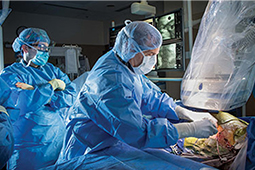Treating heart failure with a biventricular pacemaker
Cardiac resynchronization therapy, or CRT, is a treatment for heart failure. When the heart’s two lower chambers, the ventricles, don’t pump at the same time, the heart’s pumping power is decreased. In CRT, we use a device called a biventricular pacemaker to keep the chambers pumping together.
Our Electrophysiology Program is staffed by world-renowned experts in providing CRT and is the leading referral program in the region. The doctors are internationally recognized for their research and are involved with clinical trials that test the next generation of treatments.
How cardiac resynchronization therapy works

Your doctor will implant the biventricular pacemaker into your chest with a minor surgical procedure. You’ll receive medication to numb the area and help you relax, but you won’t be asleep.
Your doctor will make an incision near your collarbone and insert special wires called leads, which will be threaded to your heart. These leads will be connected to a pulse generator, which is a type of battery placed under the skin of your chest. The leads will detect if your heart isn’t beating correctly, and the pulse generator will shock the heart back into a normal rhythm.
After the procedure, you’ll be admitted to the hospital and will stay overnight. We’ll test your device to make sure it’s working properly before you go home. You’ll be able to return to your normal activities in a few days.
Conditions
Heart Failure
Heart failure occurs when your heart doesn’t fill with enough blood or doesn’t pump enough blood throughout your body.
Ischemic Cardiomyopathy
Ischemic cardiomyopathy is an enlargement and weakening of the heart’s left ventricle. This decreases the heart’s ability to pump blood throughout the body.
Tests
Chest X-ray
Chest X-rays use a small dose of radiation to create pictures of the structures inside the chest, including the lungs, heart, and chest wall.
Echocardiogram
An echocardiogram uses high-frequency sound waves to create images of your heart.
Electrocardiogram (ECG)
An electrocardiogram, also known as an ECG, measures the heart’s electrical activity.
Our providers
Location: Change location Enter your location
-
Moutasem Aljundi, MD
Interventional Radiology & Vascular And Interventional Radiology
-
Rahul Anand, MD
Cardiology
-
Tamara Ashvetiya, MD
Cardiology & Hospital Medicine
-
Erika D Feller, MD
Heart Failure And Transplantation Cardiology, Structural Heart Disease Cardiology & Cardiology
-
Raktim Kumar Ghosh, MD
Cardiology
-
Stuart Gould, MD
Internal Medicine & Cardiology
-
Shahzad Hussain, MBBS MD
Pulmonary Medicine, Hospital Medicine & Critical Care Medicine
-
Alison P. Karpa, ACNP-BC MSN
Cardiovascular Disease, Cardiology & Critical Care Medicine
-
David McNeely Roberts, MSPAS PAC
Cardiology
-
Ioana Andreea Rus, MD
-
Sunjeet Singh Sidhu, MD
Internal Medicine & Cardiac Electrophysiology
-
Margaret Stevenson, MD
Cardiology & Critical Care Medicine
-
Amanda Janney Stieglitz, MHSPAS PA
Critical Care Medicine
-
Jennifer Yu, MD
Emergency Medicine & Critical Care Medicine
-
Salahadin Mai Gharad, MD
Cardiology
-
Rajendra R. Shetty, MD
Interventional Cardiology
Our locations
Distance from Change locationEnter your location
MedStar Health: Cardiac Electrophysiology at MedStar Franklin Square - White Square Professional Building
9105 Franklin Square Dr. Suite 209 Baltimore, MD 21237
410-554-2440
MedStar Health: Cardiac Electrophysiology at MedStar Georgetown University Hospital
3800 Reservoir Road Northwest MedStar Georgetown University Hospital Washington, DC 20007
855-430-5304
MedStar Health: Cardiac Electrophysiology at MedStar Southern Maryland Hospital Center
7501 Surratts Road Suite 306 Clinton, MD 20735
301-877-4469
MedStar Health: Cardiac Electrophysiology at MedStar Union Memorial Hospital - Calvert Street Building
3300 North Calvert Street Calvert Street Building First Floor Baltimore, MD 21218
410-554-2044
MedStar Health: Cardiac Electrophysiology at MedStar Washington Hospital Center - Main Hospital
110 Irving Street, NW S5A-12 Washington, DC 20010
855-430-5304
Insurance
MedStar Health accepts most major health insurance plans. If you are uncertain as to whether your individual health insurance plan is accepted at MedStar Health, please call your insurance company.









